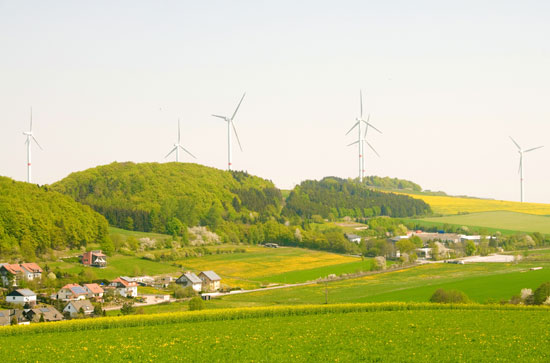Fracking has become a fixture of the American landscape and the global economy. It has upended the business models of companies in the energy industry around the globe, and it has started to change geopolitics and global energy markets in profound ways. In The Boom (Simon & Schuster, 2014), Russell Gold, an investigative reporter at The Wall Street Journal, tells the story of this once-obscure oilfield technology and it’s ability to challenge and improve the renewable energy systems.
Buy this book from the MOTHER EARTH NEWS store: The Boom
Thanks to fracking, the United States is producing more natural gas than ever. The same technology used to get gas out of shale is now being used to get oil as well. In the summer of 2013, the United States pumped nearly 7.5 million barrels a day of crude oil, a level unseen since 1990. North Dakota, home to the Bakken Shale, was producing 875,000 barrels a day, up from 150,000 barrels five years earlier. For decades, the United States has imported millions of barrels of oil every day. Imports are now falling. While it seems unlikely that America will ever become “energy independent,” it is certainly unwinding its dependence on foreign suppliers in the Middle East and Africa. For generations, the United States has used its military might to keep oil flowing, fighting wars and patrolling sea lanes. Maybe this era will now come to an end. By 2020, America could become the largest global oil producer.
Drilling wells in a more environmentally responsible manner isn’t enough for some fossil-fuel critics. They argue that burning coal, oil, and gas is releasing too much carbon and accelerating the unpredictable consequences of climate change. But not all fuel is equal in this measure. To achieve the same amount of energy, burning coal generates 42 percent more carbon dioxide than crude oil, which itself generates 18 percent more than natural gas. Critics argue that slowing the rate at which carbon is building up in the atmosphere, by burning gas instead of coal, is a half measure, and the Earth is too far into climate change for this kind of incremental progress. What is needed, they contend, is a wholesale switch to fuels that don’t emit any carbon.
Sometimes I wonder what the energy landscape would look like if the industry couldn’t frack shale rocks; if all that oil and gas were still locked away out of reach. Would there be more wind and solar power? Would we be putting liquefied corncobs and prairie grass into our fuel tanks? Would we have found ways to be more fuel efficient, investing in public transportation and insulated windowpanes?
I suspect that America would be importing huge amounts of natural gas from overseas along with the fleet of tankers that brings crude oil. Fracking has not derailed the growth of renewable energy. Electricity from renewables, power sources that emit no carbon, has grown fast. The wind provided three-tenths of 1 percent of US power a decade ago. It is now about 4 percent. Considering that American energy consumption is Brobdingnagian, that’s historic growth. Solar is also growing but remains much smaller.
Energy systems change when something better and cheaper comes along. New England’s whalers stopped harpooning when refined petroleum proved a better light source. Crude oil replaced coal in trains and boats in the first couple decades of the twentieth century because it was a more compact, capable fuel. Natural gas is making inroads because fracking allows it to be abundant and cheap, at least in the United States. Some believed that the twenty-first century belonged to renewables—and it might yet—but fracking has breathed new life into fossil fuels.
Fracking is a challenge to renewable energy systems such as wind farms and solar arrays. The glut of inexpensive gas has made it hard for renewable energy to compete on the nation’s power grids. But this competition is also forcing wind and solar to get better and, arguably, helping accelerate the maturation of these technologies. The abundance of inexpensive natural gas helped cushion the sticker shock of higher-priced renewables. Wind and sun are power sources that turn on and off. The wind doesn’t always blow, and clouds can block the sun. For the power grid to function as we expect, there needs to be something to back up this intermittent renewable energy. Coal and nuclear power plants aren’t well suited for the job. They don’t like to be turned on and off quickly. But natural gas power plants are more nimble and can hold together a mélange of renewable and fossil fuels. This possible future is on view in Texas, which leads the nation in wind power and natural gas production. One study, paid for by renewable energy advocates, concluded the path to low-carbon power generation will require both gas and renewables working together.
The global energy system is vast. It won’t change quickly. It is the foundation of modern life, and due to climate change, it poses a threat to modern life. The energy unearthed by fracking is both a once-in-a-lifetime opportunity and an enormous challenge. The rise of fracking is a story of ambition and resourcefulness. It is a tale that could occur only in the freewheeling United States, a nation of an enormous energy appetite, with no discernible policy on providing that energy, and a willingness to turn its back on Ottis Grimes. The Earth is warming, and once the source rock is depleted, the era of fossil fuel will end whether we are ready or not. Fracking has changed the energy industry and is changing the world around us. It is here to stay.
From THE BOOM by Russell Gold. Copyright © 2014 by Russell Gold. Printed by permission of Simon & Schuster, Inc. Buy this book from our store: THE BOOM
